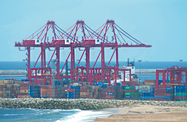Sri Lanka is looking to boost its public transport infrastructure, particularly in Colombo, amid rising passenger numbers and increased road congestion.
While several proposals in recent years have offered different strategies to improve the public transport system from a cost-effective perspective, the issue is becoming more pressing, as record vehicle imports in 2015 contributed to major increases in traffic.
Public transport’s share of journeys in the capital is also expected to rise on the back of population growth, with estimates forecasting that 60% – more than 10m – of daily motorised trips in the capital will be made via public transport in 2030. In 2013 that number stood at 4m, or 52% of the daily share.
With limited air and sea connectivity domestically, roads carry the bulk of passengers and cargo, with 93% of total passenger traffic and 97% of freight traffic travelling by road in 2012, according to the UN Development Programme’s report on Sri Lanka’s transport sector released in March.
Motor vehicle imports rose 97% year-on-year to $596.5m for the period between January and June last year, according to figures from the central bank. The uptick in imports is a result of lower import duties among other factors, such as cheaper bank credit and increased purchasing power due to salary hikes for public sector employees.
A systematic approach
A three-tiered systematic approach to transportation could help overcome this steep increase in road congestion, according to Ranjit Fernando, chairman of the UDA.
The first part of the plan would be to service seven main entry nodes to Colombo by rail or by bus, while the second tier would involve intercity bus transportation. The third tier would necessitate an inner-city transport loop, likely either mass rapid transit or monorail, which could serve the more heavily congested urban areas.
“The challenge is to have one institution in charge of all three nodes in order to synchronise, coordinate and price accordingly, and then link all of that to land use,” he told OBG.
The most costly endeavour will be Colombo’s inner city loop component. Late last year Sri Lanka’s Board of Investment indicated that proposals would be requested for either a mass rapid transit or monorail. However, by early 2016 these plans had been shelved in favour of a more cost-efficient light rail scheme, which still remains in the planning stages.
A bus rapid transit scheme, a monorail, railway modernisation and other improvements were outlined as the most viable options in the Colombo Urban Transport Master Plan, completed by the Japanese International Cooperation Agency in collaboration with the Ministry of Transport in late 2014.
More recently, Sri Lanka’s newly created Ministry of Megapolis and Western Region Development in 2015 has begun tackling the issue of public transport.
Proposals currently with the Cabinet include modernising the bus service, railway electrification and modernisation, and the incorporation of a light rail scheme as well as inland waterway routes.
The Megapolis development plan is expected to be implemented in stages and help position Colombo as a competitive global city.
The state of buses
In the meantime, upgrades to the bus system remain the most viable short-term strategy to easing the country’s transport woes, given cost constraints for more ambitious projects.
Bus service remains the dominant form of public transport, accounting for nearly half of daily motorised journeys in the capital. Services are provided by both the Sri Lanka Transport Board (SLTB), a government entity with 6268 buses in operation in 2015 transporting over 770,000 ticketed passengers, and a larger sprawling private sector.
A programme to liberalise Sri Lanka’s public transport in the 1970s aimed to ease the burden of the SLTB; however, the result has been a fragmented and unregulated landscape for private operators.
“We do not have big bus companies, but rather small and medium-sized enterprises, where one guy owns a few buses,” Nayana Mawilmada, the former director-general of the Urban Development Authority (UDA), told OBG late last year. “It is very fragmented and the lobby group is very strong.”
As a result, there is an oversupply of buses on the road from various operators, yet many of these buses are overcrowded and fail to follow regular timetables.
While the growing middle class looks to purchase private vehicles to avoid this situation, lower-income commuters continue to experience poor service on the country’s strained public transport system.
On the road to reform
The challenge to reforming the system lies less with investment and more with how to reposition existing players, according to Romesh David, president of the transportation group at Sri Lankan conglomerate John Keells Holdings.
A number of private interest groups, as well as private bus operator associations, remain invested in the status quo while the absence of an effective regulator has resulted in minimal coordination among actors.
“There are three or four groups who are socially and commercially tied to things as they are, including stakeholders around the ownership and operation of three-wheelers, buses and school vans,” David told OBG late last year. “A proper bus service, for instance, requires taking 3000-4000 buses off the road and replacing them with newer, more efficient models.”
Industry stakeholders have also suggested a wider role for the National Transport Commission (NTC). According to Amal Kumarge, chairman at Chartered Institute of Logistics and Transport Sri Lanka, properly planned routes, efficient use of state subsidies and effective control of the bus supply are all areas that could be improved by the NTC.
Oxford Business Group is now on Instagram. Follow us here for news and stunning imagery from the more than 30 markets we cover.

